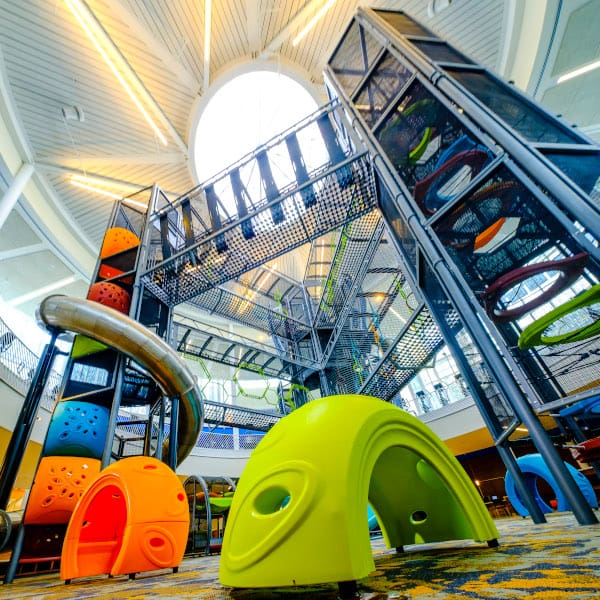Why You Should Add an Indoor Playground to Your Daycare
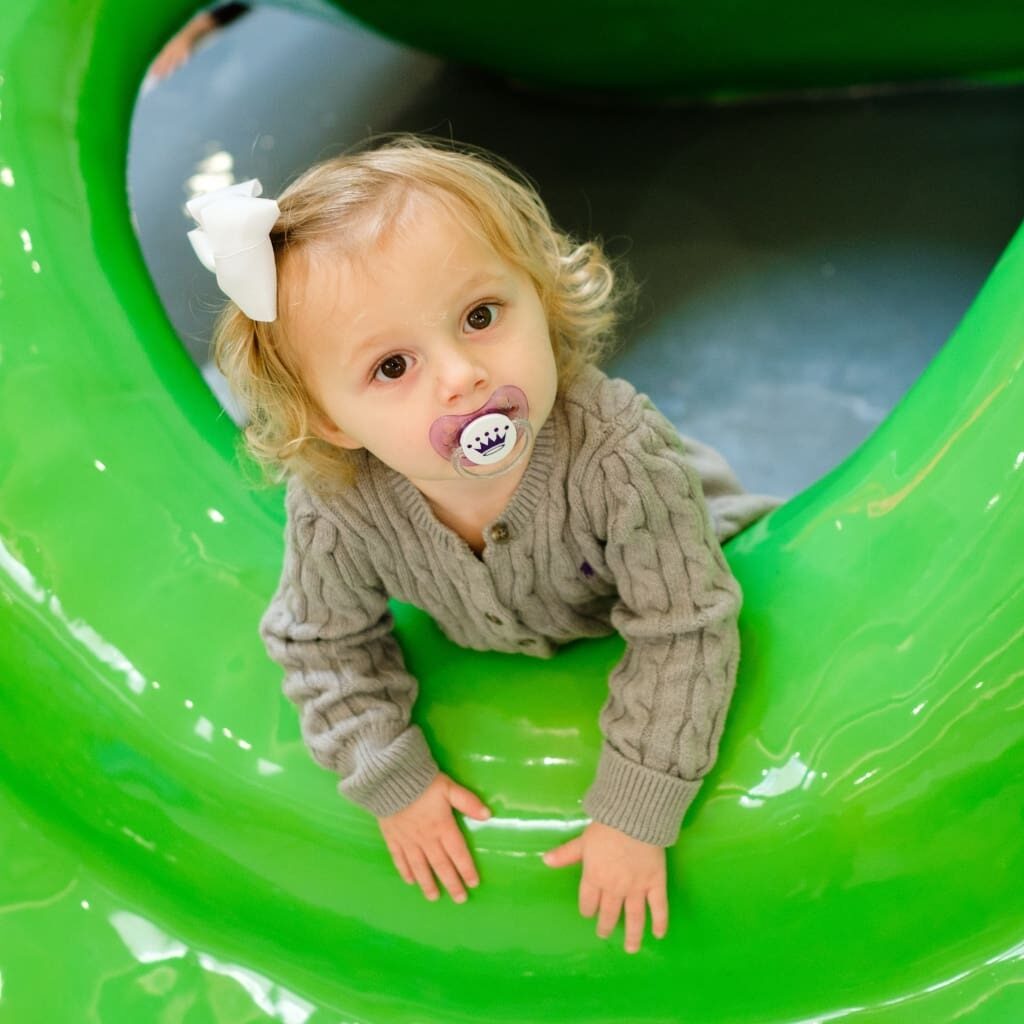
Why You Should Add an Indoor Playground to Your Daycare
When the grown-ups are away, the kids will play — at least, that’s the goal for a daycare. Daycares are all about supporting child development, but they can’t do that without effective playspaces. Time and time again, we see the benefits of play for virtually every dimension of child development, from cognitive skills to physical health to imagination. Implementing an indoor playground is one of the best ways to help kids grow and support the goals of daycare.
A good indoor daycare playground can take on many forms, but it should provide a safe and magical space for imaginations to run wild. It should also create opportunities for developing motor skills, socializing with other kids and experiencing challenges.
Read the full article or jump to a specific section:
- What Is an Indoor Playground?
- How Indoor Play Areas Support Goals
- The Benefits of Indoor Playgrounds for Children
- Best Equipment to Include in an Indoor Playground
- How to Keep Your Daycare’s Indoor Playground Safe
- Create Your Daycare’s Indoor Playground With Soft Play
What Is an Indoor Playground?
When we picture a playground, we typically think of an outdoor structure. Indoor playgrounds are a bit different. They tend to offer more creative freedom with unique and exciting pieces. They can blend in perfectly with your interior decor or transport kids to faraway settings like pirate ships or giant gardens.
Indoor playgrounds might take many forms, from a small cushioned area with a few sculpted-foam critters to a decked-out climbing tower with interactive features. They can be made of soft materials and placed on cushioned surfaces for extra safety, which is particularly useful for young kids. The possibilities are endless, allowing kids to play in the comfort of the indoors with safe yet engaging pieces.
How Indoor Play Areas Support Goals
Indoor playgrounds are especially great for daycares because they can help you meet business and care goals while solving a few common problems with playtime. Indoor playgrounds offer:
- Year-round play: While outdoor playgrounds are great, kids can’t use them if the weather doesn’t cooperate. Snow, rain, wind — none of it matters if your playground is indoors. You don’t need to worry about excessive heat that could become dangerous or spend time messing with coats and gloves.
- Easy monitoring: In an outdoor playground, kids might be able to run off in any direction, and caregivers need to keep a sharp eye on them. While supervision is still necessary for indoor playgrounds, it’s usually easier to keep an eye on kids when they stay in the confines of the daycare building.
- Support for mental and physical development: Playgrounds have a lot to offer for various types of development. Playtime has a vital role in building up emotional, social and physical skills, and an indoor playground allows daycares to better focus on these abilities.
- Differentiation from the competition: Indoor playgrounds can be a unique way to set yourself apart. Parents like to know their kids will be attending a daycare that puts healthy development first. A playground can illustrate that commitment and help you offer more comprehensive care. It can also be an eye-catching addition to the building, sure to grab attention when you show prospective parents around.
- Appropriate spaces for young kids: Not all outdoor playgrounds are suitable for young kids. Many indoor playground elements are soft and squishy, making them appropriate for your littlest attendees.
In short, indoor playspaces can help kids stay safe while learning about the world, themselves and others — the primary goal of a daycare.
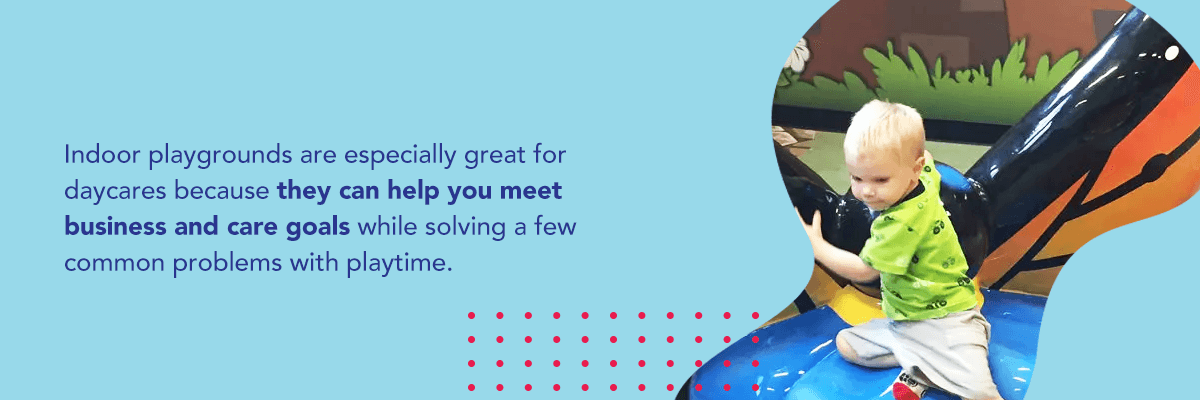
The Benefits of Indoor Playgrounds for Children
Many kids attend daycare daily, so they’re in the same environment for several hours each week. An indoor playground can offer unique, magical environments that keep them engaged every time they enter your doors. Kids can create stories all year long to fuel the essential learning that happens on a playground.
Playtime might seem like a fun way to blow off steam, but kids are doing much more than that when they play. They’re creating new connections in the brain in areas like motor skills, socialization, imagination and physical health. While they play, kids are building the foundation for deeper learning that helps them grow and develop.
Below are some of the benefits of daycare playground equipment:
1. Playgrounds Help Kids Learn to Use Their Imaginations
One of the clearest advantages of indoor playgrounds is their ability to unleash imagination. If you’ve ever stepped foot on a playground, you’ve probably seen just how creative kids can get. They often play make-believe, putting themselves in new environments and acting out new characters. A platform becomes a ship’s roost, and a child becomes a captain. Other kids might take on the roles of crewmates and explore the dynamics that come with them — the possibilities are endless.
These activities can help kids develop their personalities as they build a better sense of self, play with other kids and discover their likes and dislikes. It stretches their creative muscles and gets kids in the habit of using their imaginations. Kids take full advantage of these imaginative spaces when they get to engage in free play, something that playgrounds can foster perfectly.
Free play differs from structured play like sports in that kids get to choose how they want to play. They put their minds to work as they transport themselves to new places, explore their natural interests and socialize with others. With the help of exciting free play and magical spaces, kids hone a variety of new skills.
Indoor playgrounds are especially useful for encouraging creativity because they can take on just about any shape or design and be used during cold or rainy days. With an indoor playground, creativity never has to end.
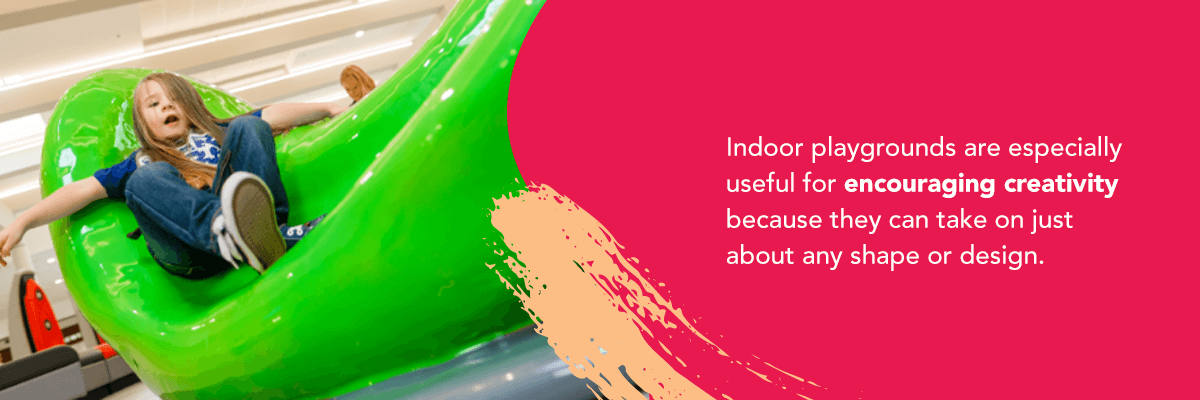
2. Playgrounds Help Kids Learn to Socialize
Kids are constantly developing social skills, and playgrounds let them interact with a wide range of peers. The playground allows kids of all ages to come together and interact, helping each other learn through socialization. They put themselves in situations they typically can’t experience in real life, helping them practice socializing in broader contexts.
Storytelling is a major part of socializing on a playground. Make-believe scenarios help kids experience new social situations and work their way through them. As they roleplay and pretend, they might find themselves collaborating with other kids or resolving conflicts — how do they decide who gets to be the queen or use the wavy platform as their boat?
Kids learn a wide variety of social skills as they play with others, such as:
- Cooperation
- Social norms
- Turn-taking
- Resolving conflict
- Sharing
- Overcoming shyness
- Making friends
As they learn these skills and communicate with others, kids also work on language. From expressing themselves politely to listening to their conversation partners, kids experience more exposure to language and learn to use it more effectively.
Studies have found significant relationships between pretend play and language. During play, kids use syntax and combine words creatively to fulfill the needs of fantasy while practicing and becoming competent in using speech tasks in various contexts. They get practice with more advanced tasks, too, like putting parts of a story together logically.
Socialization is a powerful tool for language development, and playgrounds are the ideal place for it to happen.
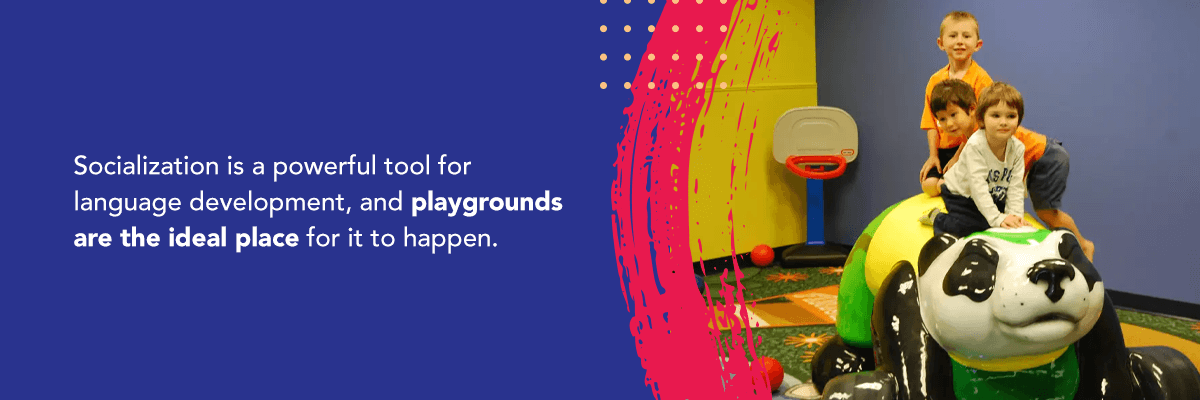
3. Playgrounds Help Kids Learn Motor Skills
Kids are highly active, and whenever they move, they practice their motor skills, which are necessary for everyday tasks like balancing, grasping objects and using utensils. Playtime is great for practicing both types of motor skills:
- Fine motor skills: Fine motor skills call for more precision and coordination than gross motor skills. They often rely on hand-eye coordination and manual dexterity. Some examples include gripping and manipulating objects and using both hands for a task.
- Gross motor skills: Gross motor skills use large muscle groups and broader movements. These include movements like walking, jumping, climbing and kicking. Some, like catching a ball, also use hand-eye coordination. Flexibility and balance also fall under the category of gross motor skills.
On an indoor playground, kids can climb and crawl over various structures and interact with various elements like games or musical instruments. They have plenty of opportunities to move their bodies and practice fine and gross motor skills.
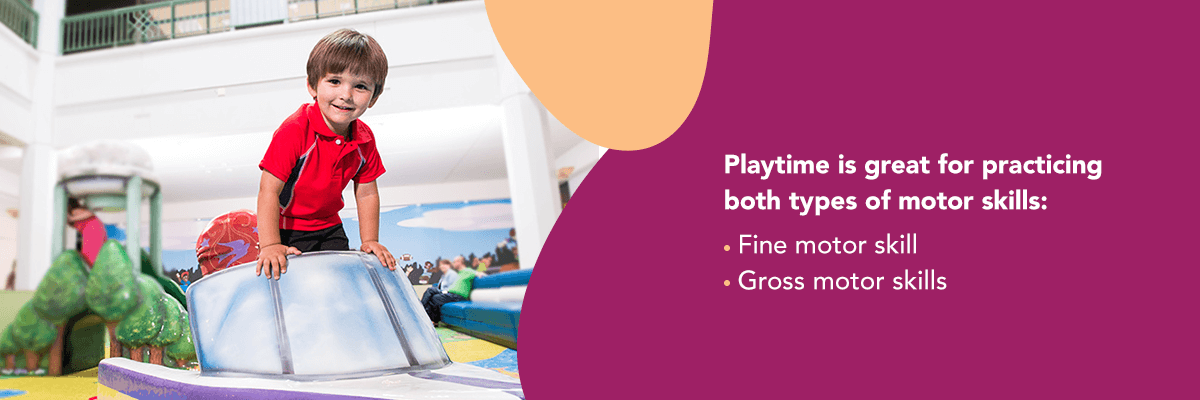
Playgrounds can also help with motor skills by offering engaging sensory environments. Interesting textures and visuals can be inviting, especially for kids who already want to touch everything in sight. They can use their hands and engage their senses while they play.
4. Playgrounds Help Kids Stay Healthy
The Centers for Disease Control and Prevention (CDC) recommend that preschoolers are physically active throughout the day. School-aged kids should complete at least 60 minutes of moderate-to-vigorous physical activity daily. The CDC recommends this level of exercise for different reasons. Of course, it affects many aspects of physical health, like muscle strength and fitness, but it can also help reduce emotional issues such as depression and anxiety.
Physical activity is associated with benefits like:
- Reduced risk of depression
- Stronger muscles and better endurance
- Improved blood pressure and aerobic fitness
- Maintenance of normal blood sugar levels
- Reduced risk of chronic diseases like type 2 diabetes and obesity
- Stronger bones
- Healthy weight and reduced body fat
Playgrounds are ideal for helping kids get their daily dose of activity. For starters, it offers a full-body workout. Arms, legs, core, cardiovascular system — you name it. Kids typically work their entire bodies when they play, helping them get a well-rounded workout with the right kind of physical activity for staying healthy.
Promoting physical activity through the playground is also useful because it helps kids see fitness as an enjoyable experience. Many adults see physical fitness as a chore. A playground that gets the blood pumping and shows kids that fitness is fun can help encourage them to remain active as they get older.
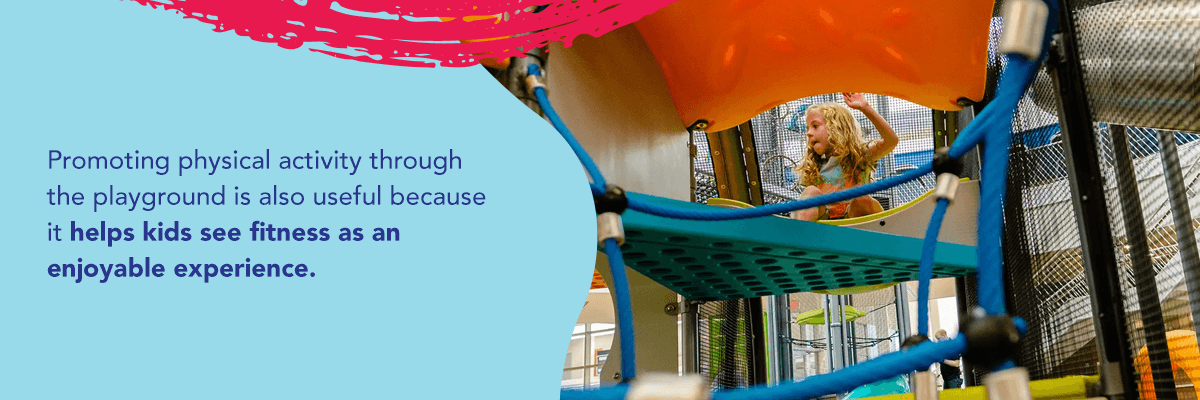
Healthy lifestyles require long-term commitments and mindsets that value physical activity. Emphasizing playground time is one way to support a lifelong love of movement.
5. Playgrounds Help Kids Develop Cognitive Skills
At first glance, playgrounds and learning might not sound like they go together. As it turns out, play has a significant role in the development of cognitive skills. Play offers various cognitive benefits that impact everything from decision-making to classroom behavior.
According to animal research, play can even directly impact brain structure and functioning. Studies have suggested that play initiates lasting changes to the prefrontal cortex and helps promote learning and adaptive and prosocial behavior.
The effects of play can span many aspects of the brain, offering benefits in areas like:
- Executive functioning: Executive functioning refers to how we learn and includes the process of “switching gears” or making transitions between tasks. It also affects inhibitory control, like impulsiveness, emotionality and aggression. Executive control is another skill honed by play.
- Problem-solving and math: During playtime, kids also develop skills in problem-solving and traditional school subjects like math. Math is all about the relationships between and among objects. Many types of play, especially construction play, support this type of learning.
- On-task behavior: The benefits of play transfer outside of the playground, too. One study found a positive link between the level of play activity before learning time and the level of on-task behavior in the classroom. Students play to relieve stress, take a brain break and get moving. Playtime can be especially good for children with attention issues because it helps them use excess energy and build executive functioning skills.
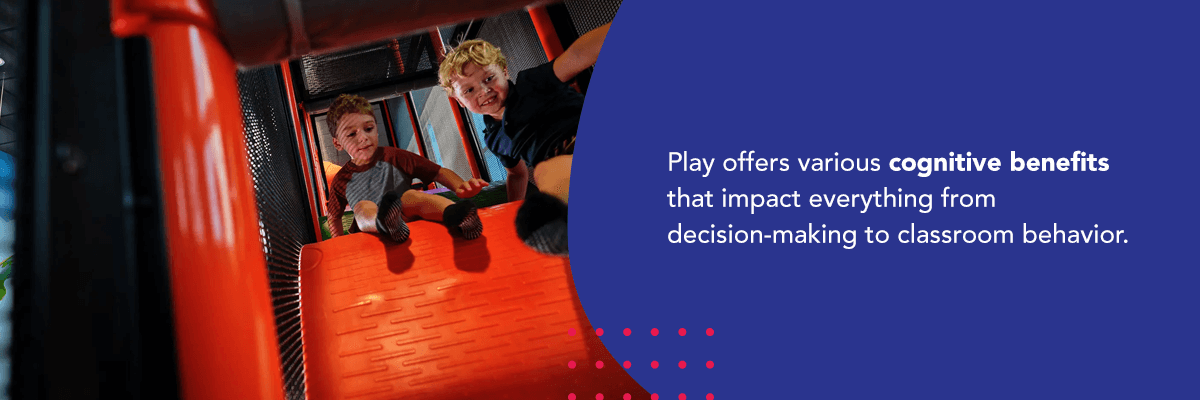
6. Playgrounds Help Kids Emotionally
We know that playgrounds are fun, but the emotional benefits go far beyond a good mood. Playgrounds are a great way to help kids learn about emotional regulation. They offer a healthy outlet for relieving stress and can help them deal with their big emotions.
Many of the emotional benefits of play go hand-in-hand with socialization and imaginative play. While they engage in these kinds of play, kids learn more about regulating their emotions. They may need to stay calm in the face of a frustrating situation or control their impulse to say something that might upset their playmates.
Using their imaginations allows children to go a step further and experience deeper emotional play. As they take on other roles during pretend play, they may experience emotions that differ from what they experience in real life, giving them a chance to practice dealing with new feelings.
As they build a repertoire of experiences, kids cultivate their self-confidence and self-esteem. The more they learn to do and the more challenges they overcome, the more confident they are in their abilities. They get opportunities to experiment with freedom and risk, building trust in themselves. Tackling challenges can also help them gain a sense of control over their environment, something kids don’t get very often.
The emotional benefits of play are wide-reaching, and indoor playgrounds allow kids to reap these benefits every day they attend.
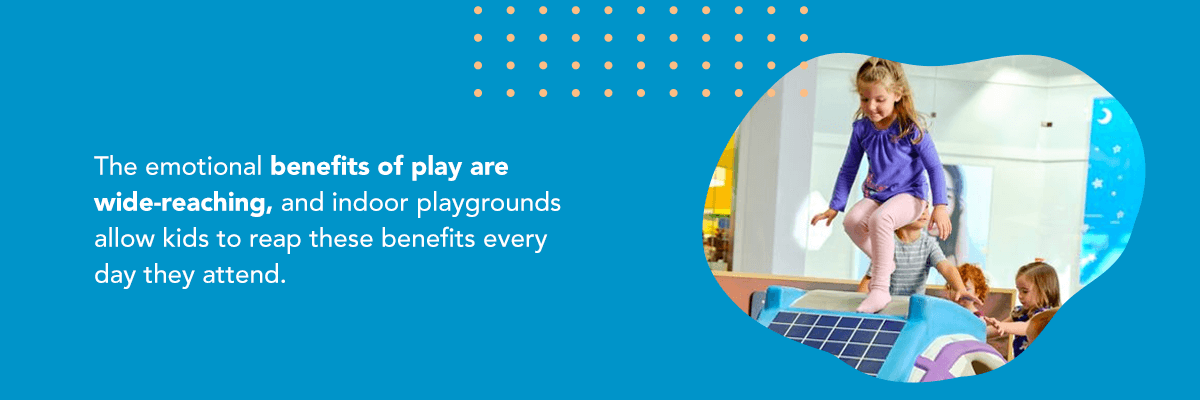
Best Equipment to Include in an Indoor Playground
Indoor play spaces are a great way to support child development, but every playground is unique, and indoor playgrounds differ significantly from outdoor playgrounds.
To start, they can be made of different materials that are safer and softer while offering plenty of creative freedom. Whether you want a realistic dinosaur or a creative version of modern art, you’re only limited by your creativity. You can match your indoor playground to the needs of your daycare with versatile, easy-to-clean elements suitable for kids of all ages.
Soft Play® offers a wide range of indoor playground equipment to help you support your littles with an engaging and exciting play space. Some of our favorite elements for indoor daycare playgrounds include:
- Sculpted play pieces: Sculpted play pieces are ideal for unlocking the power of imagination. They add some magic to the daycare with various shapes and designs. Kids can crawl through tunnels and hop across “rocks” with these versatile pieces. Sculpted foam pieces are easy to maintain, great for young kids and make a memorable addition to any indoor space.
- Small towers: Get kids off the ground with small towers, which add height and exciting features while maximizing your floor space. They allow kids to climb and crawl to their hearts’ content as they move through creatively designed platforms and challenges. These towers are easily customizable to fit your layout.
- ATOM: ATOM is another awesome choice for small spaces, packing numerous features into a compact package. It has a customizable appearance and a rugged Ruffnet barrier to help keep kids safe while playing. Some features they can enjoy include a slide, hammock, climbing structures, drums and wavy platforms.
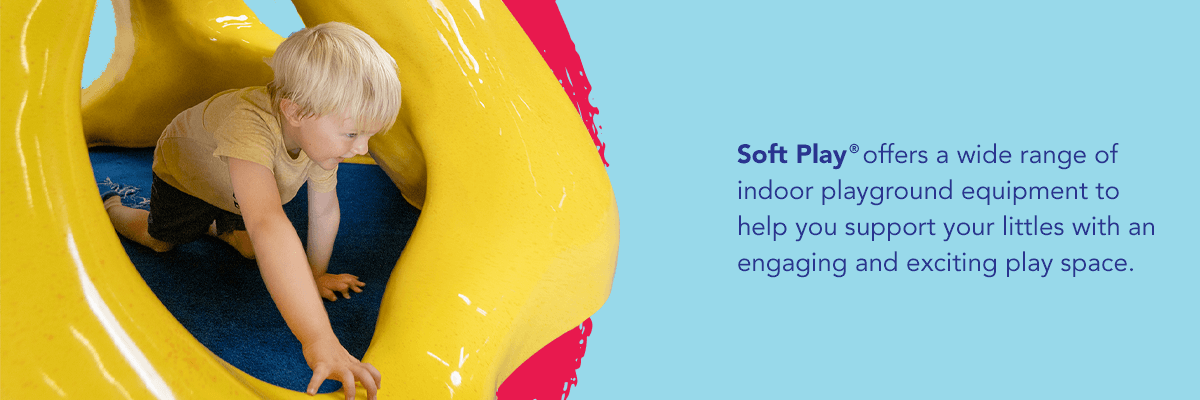
How to Keep Your Daycare’s Indoor Playground Safe
No play situation is 100% safe. Indoor playgrounds might use softer materials, but remember that they’re still playgrounds. Kids can play rough, so the equipment you choose should make it easier to keep them safe.
If you’re building a playground for younger kids, consider sticking to soft materials like sculpted foam. If your playground has heights, make sure it has a barrier to help keep kids in, such as tough netting. No matter what the playground looks like, it should be easy to clean — kids can make messes fast.
Always buy high-quality playground equipment from a manufacturer you can trust. Look for one with the know-how and reputation to back their work. Here at Soft Play, we have decades of experience and put our equipment through robust testing criteria to ensure it stands up to whatever your kids throw at it.
In addition to your choice of equipment, you’ll need to adopt some safe behaviors about playground use. Below are some tips for keeping your indoor playground as safe as possible:
- Never leave children unsupervised: Even though indoor playgrounds can be safer than their outdoor counterparts, kids should never be left unsupervised. Keep a close eye on them at all times.
- Establish playground rules: Before anyone steps foot on the indoor playground, establish clear rules. Everyone needs to understand them if they want to play on the playground. If kids break your rules, be firm and make sure they understand why it’s so important to follow them.
- Disinfect your playground often: Set a schedule and stick to it. A daily cleaning regimen can help you keep germs off the equipment and out of kids’ mouths. This task doesn’t need to be time-consuming, either. With easy-to-clean equipment, you can quickly wipe it down and move on with your day.
Create Your Daycare’s Indoor Playground With Soft Play
We’ve been helping kids unleash their creativity through engaging and magical playground elements since 1984. With Soft Play elements, you can attract more families to your daycare and help kids grow and develop into intelligent, active adults. Our playground structures can transport kids to wherever their imaginations roam. While there, they get to practice and hone a wide range of essential skills.
